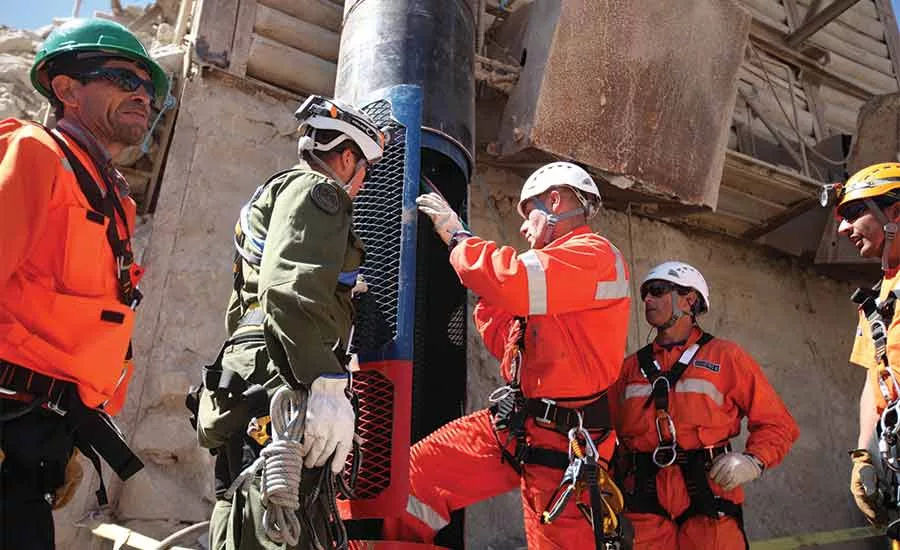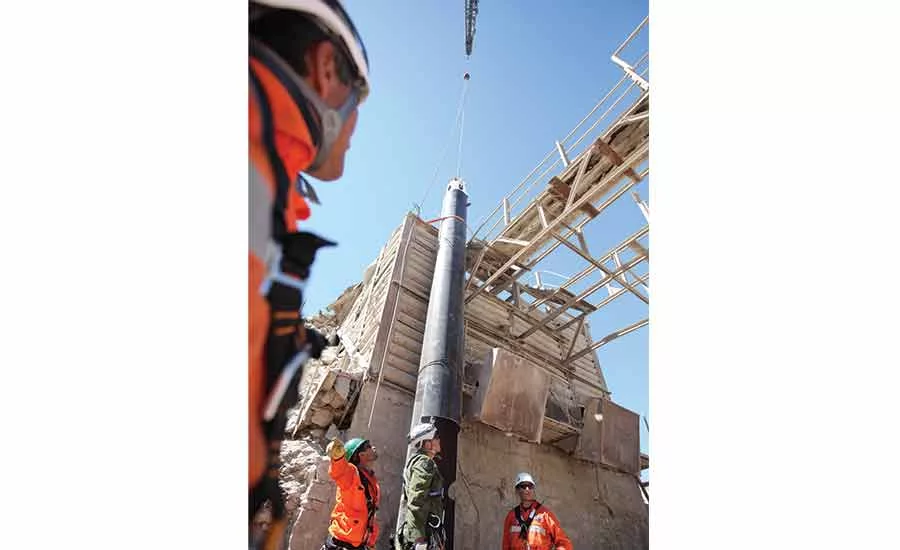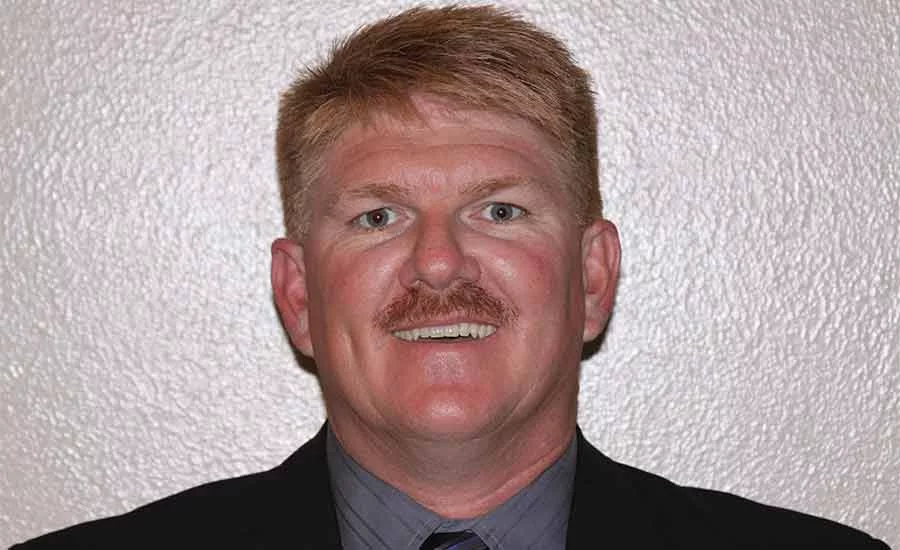Using Chilean Mine Rescue to Inspire Future Drillers

Rescue workers prepare for a dry run of one of the rescue capsules designed to retrieve trapped miners near Copiapó, Chile, on Oct. 11, 2010. The rescue was completed a few days later.
Source: Hugo Infante / Government of Chile photos


Jeff Hart now gives talks about the Chilean Mine Rescue, hoping to inspire a new generation to consider careers in drilling.
Source: Jeff Hart

Crews work on a platform around the escape hatch where the rescue capsules would be lowered to the trapped miners.
Source: Hugo Infante / Government of Chile
Drilling makes a difference. Just ask Jeff Hart.
The Chilean Mine Rescue captivated the world eight years ago last month. While the collapse happened Aug. 5, 2010, at the mine north of Copiapó, Chile, news 17 days later that 33 miners survived and were trapped a half-mile below the surface grabbed the world’s attention. Hart, the director of field operations for Layne, got a satellite phone call on a jobsite half a world away, in Afghanistan. He and a team rushed to Chile to help. The rest is history: the team of Layne drillers (and others), a Schramm T130XD and hammers from Center Rock reached the miners first. They widened that pilot hole into the 28-inch shaft that allowed rescue using specially built rescue capsules. The 33 miners were brought back to the surface on Oct. 13.
Now, Hart uses the experience to stoke interest in drilling — the profession he’s dedicated his life to — among the next generation. National Driller saw his presentation at the National Drilling Association (NDA) annual convention in September and caught up with him afterward to talk about the rescue, its legacy for him and his training efforts.
Our conversation here is edited for space and clarity.
Q. First off, from a technical standpoint, tell me about the biggest challenge for your team on the Chilean Mine Rescue effort.
A. You know from a technical standpoint, the biggest challenge was actually getting the cluster drill, which is the five-hammer tool, to actually drill at an angle, just because it wasn’t meant to do that. So we were literally making design changes and engineering changes on the fly, and it was being done at site. We called into Pennsylvania, they were making the parts, loading them on UPS and then shipping them to us. That was the toughest part, was to actually get that hammer to work to where we could get … you know, the more meters we could get out of every hammer, the quicker we can get there.
Q. As you’re trying to drill at an angle with this cluster drill, how is it behaving? What is the issue with drilling at an angle with a drill like that?
A. It just side loads the bearings, the brass bearings, and so when it side loads those brass bearings, we found out in short order that they just can’t take that side load. They’re made for direct upload. So, with that side load, the bearings would break. The bit manufacturers were doing a great job making changes on the fly to give us the pieces that we needed.
Q. What was the mechanical fix for this, or were they just beefing up the materials to help withstand what you were trying to put it through?
A. Exactly. There were a number of changes that we went through, from removing the bearing and making it part of the chuck and ... you know there were a number of different changes that we went through, but it was basically just beefing up the tool to allow it to do what we were trying to do.
Q. Has how you think about this rescue changed in the eight years since it happened and, if so, how?
A. You know we hope we, obviously, never have to do it again. But no. How we would have approached it, everything would have been exactly the same. It was a good, proven method — the way that we’ve done additional work before. Basically, we were using the same method as we do when you’re drilling an air vent hole or a slickline for concrete down into a mine. We use a small-diameter borehole to get it into the spot that we need it, then we use that pilot hole as a guide to upsize the hole. We used the same theory there. So everything would be the same.
Q. You do seminars now to educate people about drilling careers. Was that inspired by what happened in Chile?
A. You know, that’s just been a goal of mine. What happened in Chile is something that students are familiar with, and so that’s the point we use for excitement that this could be the industry that they can get in. But, obviously, this industry is a dying breed, so we have to get the word out to as many kids as we can that this is a great industry to be in and there’s a necessity for it. That’s really the key. The big thing for the rescue is just that we can utilize that as something that the kids are familiar with so they know what we’re talking about.
Q. When you’re giving these presentations, what aspects of the rescue intrigue kids in the age groups you’re talking to?
A. It depends on the age group. We use the aspect of the rescue [to illustrate], you know, this is a very important job. ... In the industry today, we’re deemed as “just roughnecks.” You know, if you want to look at it like that, that’s okay. But, realistically, what this can lead to is a situation like this where it takes [our expertise] to get people out of the ground. We hope it never happens again, but it worked once and so, because of that, there’s always the option there in any type of an underground rescue. Then we go into [other aspects like] you get to travel the world, you get to see everything, you know, if you really want to do this. I’m just a young kid from a very small farming town, and to be able to see the entire world in the drilling industry is phenomenal.
Q. When you describe the profession to these young people, what kinds of questions are they asking you?
A. A lot of them are about travel, but they’re also looking for, “Is it always in the field? Are there jobs that, you know, once you get to a certain age, you can move into an office atmosphere?” [It’s a] lot of questions like that. It’s kind of exciting for me because I know that they’re thinking about a long future, you know what I mean? That they’re looking way ahead, not just at a paycheck today.
Q. What can individual contractors do to help bridge the age gap in the drilling industry?
A. You know, we all have to get out and educate as much as we can in this industry to let people know that it is becoming more and more advanced. It’s not as archaic as maybe people think that it is. So the more education that we can do, the more kids will understand that everything has gone to joystick, you know, stuff like that. We have to just educate. Everybody in the industry has to talk to younger people.
Q. What are the age ranges that you’re presenting to?
A. Everything from middle school ... so sixth grade at the youngest through college-age students. We try to get in as many high school, tech school areas as we can, and then as many of the mining schools as we can that have, you know, an emphasis on mining.
Q. Like SD Mines or something like that?
A. Right, you know, Colorado School of Mines, Texas A&M. We try to get in as much as we can.
Q. Are you just doing these in the States or abroad too?
A. Just in the States. We’re really just starting to get this push going now to get in as many as we can. The ones that we’ve done, we’ve been invited to do just because we have contacts — somebody that’s in the school to say to, “Hey, how can you get us in front of this or that?”
Q. What advice do you give to young people considering careers in drilling?
A. Just to take a good, hard look at it. It is hard work to start, but it’s a great opportunity to see the world and get your feet underneath you at a young age. You can make good money. And it’s a fun job that comes with a family atmosphere. So, it’s going to be to really just take a good, hard look at it.
Q. Are there misconceptions about the rescue that you’d like to clear up, things that you’ve seen misreported or things that you’ve seen, you know, propagated out there that aren’t quite accurate?
A. You know, there’s a lot of them, but it’s nothing that I need to clear up. Again, there’s a lot of [reports] that are accurate. So that’s what really counts in my mind. There’s some inaccuracies out there. But, if you have 10 people that all watch a car accident, everybody sees something a little bit different. It’s kind of the same thing. So, really, no.
Q. How has being a part of this changed the course of your career?
A. Really, I would say I don’t know that it changed a whole lot, from where I thought I was going to where I would be. But it’s definitely changed the way that you can talk to people because they have a whole new respect for something that happened in the past. Because of that, there’s a tie to it. So it’s much like me doing a presentation that, you know, like this last week, had the rescue not been there, I probably wouldn’t have been afforded the opportunity to talk and to be around those people. So that part of it has changed because there is something that everybody’s familiar with that they want to hear about. It puts my name out there in the industry, obviously, a little more.
Q. What are your thoughts on being played by James Brolin in the movie “The 33”?
A. Well, I must look a lot older than I feel. [laughs] But you know it’s — again, as I said in the presentation today — a huge honor just to have your name in the movie that was done in Hollywood. It’s pretty cool to have all of that.
Looking for a reprint of this article?
From high-res PDFs to custom plaques, order your copy today!



